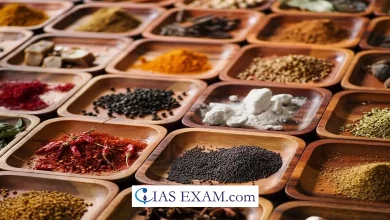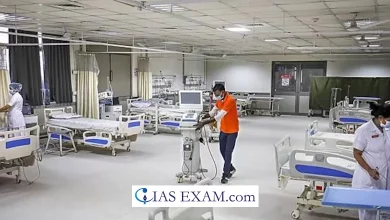Limiting the Consumption of Processed Foods
GS Paper 3 - Food Processing, Agri Marketing

Context
India, like many other countries, is undergoing a major “nutrition transition”. In what characterizes rapidly changing dietary patterns, there is a significant shift away from traditional diets, which were high in fiber and comprised mostly whole foods, to more western-style diets, which are processed and high in calories.
This change has coincided with rapid economic progress and urbanization along with a surge in the consumption of packaged and processed foods (popularly called “junk foods”).
What are Junk Foods?
- Junk foods have a lot of calories, carbohydrates, bad fats, and salt but very little nutrition. These foods are frequently overly processed and lacking in fiber, vitamins, and minerals.
- Junk foods include fast foods like burgers, fries, and pizzas, sweet snacks like cookies, candies, and drinks, and salty snacks like chips and pretzels.
- Obesity, heart disease, type 2 diabetes, and dental problems are all potential consequences of eating junk food on a regular basis. These meals are generally easy and tempting, yet they provide little nutritious value.
Concerns with Junk Foods in India
- Termed as HFSS Foods – Scientific data reveals that junk food, which is high in fats, salts, and sugars (HFSS), weakens the body’s immune system, raises blood pressure, causes a surge in blood sugar, causes weight gain, and contributes to an increased risk of cancer.
- Rise in Lifestyle Diseases – It should come as no surprise that India is facing a surge in lifestyle diseases, with poor nutrition being one of the leading causes. An Indian Council of Medical Research (ICMR) study published in 2023 estimates that the prevalence of metabolic disorders in India is alarmingly high, with 11% having diabetes, 35% hypertensive, and nearly 40% suffering from abdominal obesity.
- Aggressive Advertising – The effect of aggressive advertising to promote “tasty” and “affordable” comfort meals, particularly among younger customers, is an important issue to consider while analyzing Indians’ changing eating patterns. According to a Centre for Science and Environment (CSE) survey performed across India, 93% of youngsters consumed packaged food, 68% drank packaged sweetened beverages more than once a week, and 53% ate these meals at least once a day.
- High Glycemic Load – There is a large body of research to show the rising relevance of diet GI and GL. The relationship between high GI and GL diets and the incidence of type 2 diabetes was recently established. However, what is less understood is the connection of high GI meals with cardiovascular disease and death.High-GI diets include sugar and sweets, white rice, maida, potatoes, white bread, sweetened beverages, jaggery, and biscuits.
- Processed Baby Foods – For a one to two year old child, companies such as Nestle recommend giving twelve scoops or 100 grams of baby food (such as Cerelac) per day. This implies the infant consumes 24 grams of sugar each day. Extra sugar in a young baby’s diet puts unneeded strain on the pancreas, resulting in the creation of excess insulin, which may contribute to diabetes and obesity in the future.
Measures to address the Concerns
SC’s Ruling – A ruling by the Supreme Court of India, in 2013, offers a constitutionally sound place to begin. The Court emphasized that any food article which is hazardous or injurious to public health is a potential danger to the fundamental right to life guaranteed under Article 21 of the Constitution of India.”
Effective Implementation of FSSAI Regulations – As children are more exposed to the advertising of unhealthy foods, the FSSAI released the Food Safety and Standards (Safe food and balanced diets for children in school) Regulations, 2020, restricting the sale of HFSS in school canteens/mess premises/hostel kitchens, or within 50 meters of the school campus. This regulation’s effective implementation needs to be ensured by all companies.
Need for Comprehensive Legislation – The first step would be to implement a comprehensive law that clearly defines what is ‘healthy’ and ‘unhealthy,’ including all beverages and foods. There is already a draft notification on front-of-pack labelling and high fat, sugar, and salt foods that has received feedback from all stakeholders but has yet to be adopted. This requires parliamentary approval.
Promoting Seasonal Fruits and Vegetables – This can include multimedia messaging on the health effects of junk foods; campaigns based on “vocal for local” that promote local and seasonal fruits and vegetables, as well as traditional foods like millets; and interactive discussions on balanced diets and the use of social media influencers to mainstream conversations about the health risks of junk foods.
Conclusion
It is vital to recognize the necessity of changing to better diets and developing public demand, or, as the Prime Minister puts it, a “Jan Andolan” or people’s movement, for healthy and nutritionally diversified meals. These initiatives must be supported by genuine policy measures that enable Indians to exercise their right to make informed food choices. Individuals can minimize their intake of harmful additives, extra sugars, and refined grains found in processed meals by choosing whole, minimally processed foods high in nutrients, fiber, and key vitamins. This proactive approach not only benefits physical health, but it also increases mental clarity and long-term energy levels.
SOURCE: The Hindu





.png)



